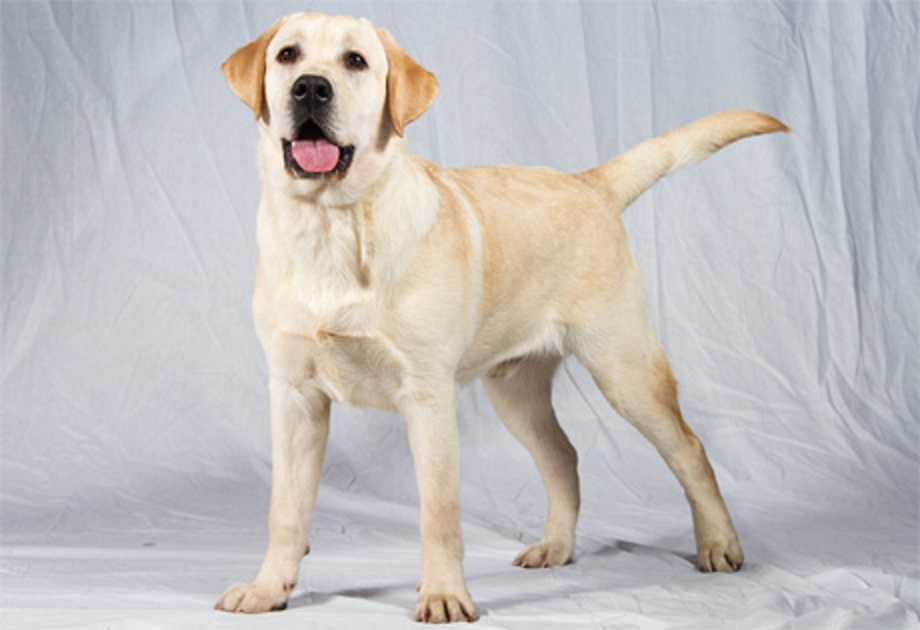
Labrador Retriever

Navigate through the tabs
Navigate through the tabs below to view the breed's info of your interest.
The breed's info is divided in four sections; namely:
the breed's history ,
the breed's main stats ,
the dog's potential health issues
and finally, how the breed scored in 26 different categories.
All the above information should give you a respectively good overview for the dog of your interest.
Dog Breed's Main Info
The Breed's History:
Labrador Retrievers hail from the island of Newfoundland, off the northeastern Atlantic coast of Canada. Originally called St. John's dogs, after the capital city of Newfoundland, Labs served as companions and helpers to the local fishermen beginning in the 1700s.
The dogs spent their days working alongside their owners, retrieving fish who had escaped hooks and towing in lines, and then returned home to spend the evening with the fishermen's family.
Although his heritage is unknown, many believe the St. John's dog was interbred with the Newfoundland Dog and other small local water dogs.
Outsiders noticed the dog's usefulness and good disposition, and English sportsmen imported a few Labs to England to serve as retrievers for hunting. The second Earl of Malmesbury was one of the first, and had St. John's dogs shipped to England sometime around 1830. The third Earl of Malmesbury was the first person to refer to the dogs as Labradors.
Amazingly, Labs - now America's most popular dog - were almost extinct by the 1880s, and the Malmesbury family and other English fans are credited with saving the breed. In Newfoundland, the breed disappeared because of government restrictions and tax laws. Families were allowed to keep no more than one dog, and owning a female was highly taxed, so girl puppies were culled from litters.
In England, however, the breed survived, and the Kennel Club recognized the Labrador Retriever as a distinct breed in 1903. The American Kennel Club followed suit in 1917, and in the '20s and '30s, British Labs were imported to establish the breed in the U.S.
The breed's popularity really began to take off after World War II, and in 1991, the Labrador Retriever became the most popular dog registered with the American Kennel Club - and he's held that distinction ever since. He also tops the list in Canada and England.
Today, Labs work in drug and explosive detection, search and rescue, therapy, assistance to the handicapped, and as retrievers for hunters. They also excel in all forms of dog competitions: show, field, agility, and obedience.
Country of Origin:
Canada
Breed Group:
Sporting
Height:
1 foot, 9 inch. to 2 feet (53,34 to 60,96 cm)
Weight:
55 to 80 pounds (24,94 to 36,29 Kg)
Life Span:
10 to 12 years
Potential Health Issues:
Elbow Dysplasia,
Hip Dysplasia,
Epilepsy,
Progressive Retinal Atrophy (PRA),
Cataracts,
Osteochondrosis Dissecans (OCD),
Tricuspid Valve Dysplasia (TVD),
Myopathy,
Gastric Dilataion-Volvulus,
Acute Moist Dermatitis,
Cold Tail,
Ear Infections
Adaptability
Apartment Living:
First Time Owners:
Sensitivity:
Being Alone:
Cold Weather:
Hot Weather:
Friendliness
Affection With Family:
With Kids:
With Dogs:
With Strangers:
Health and Grooming
Shedding:
Drooling:
Easy To Groom:
Overall Health:
Weight Gain Potential:
Size:
Training
Easiness:
Intelligence:
Mouthiness:
Prey Drive:
Barking or Howling:
Wanderlust:
Need For Exercise
Energy Level:
Intensity:
Exercise Needs:
Playfulness:
Our Mobile Application
Check out Our Mobile Application "Dog Breeds Central"
